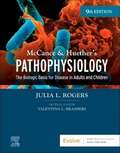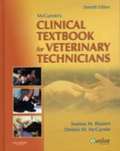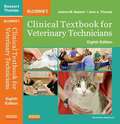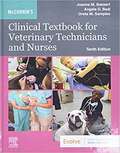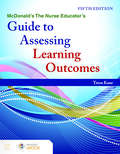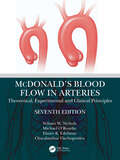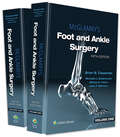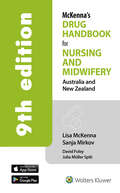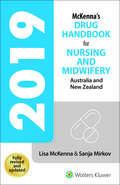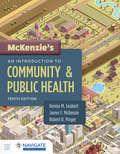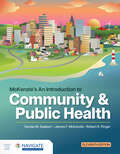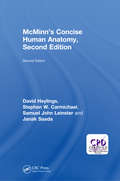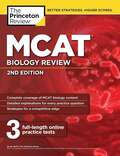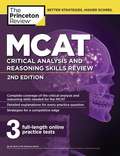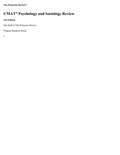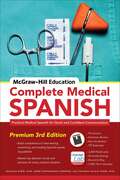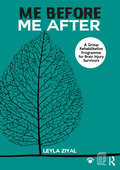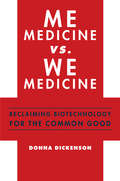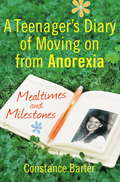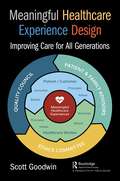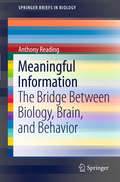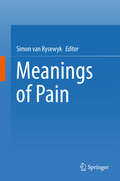- Table View
- List View
McCance & Huether’s Pathophysiology
by Julia RogersLearn the what, how, and why of pathophysiology! With easy-to-read, in-depthdescriptions of disease, disease etiology, and disease processes, McCance and Huether’s Pathophysiology: The Biologic Basis for Disease in Adults and Children, 9th Edition helps you understand the most important and most complex pathophysiology concepts.
McCurnin's Clinical Textbook for Veterinary Technicians (7th edition)
by Joanna M. Bassert Dennis M. MccurninWritten by veterinarians, board-certified specialists, and veterinary technicians who understand the vet tech curriculum, this fundamental text in veterinary technology contains sections on small and large animals, birds, and reptiles to embrace every aspect of the veterinary field. Case presentations link information to real-life scenarios commonly encountered in practice, with color and b&w photos depicting specific disorders, diseases, and procedures. Descriptions of procedures offer detailed information on the technician's role, while chapters on pharmacology, pain management, restraint, and veterinary oncology offer a broader understanding of the technician's responsibilities. This seventh edition provides new cases and increased coverage of large animal concerns, such as nutrition, emergency nursing, and anesthesia. There are also new chapters on physical therapy and rehabilitation, as well as expanded sections on anesthesia, nursing, and dentistry. Newly added key terms, a glossary, outlines, and learning objectives aid studying. Bassert is professor and director in the Program of Veterinary Technology at Manor College. McCurnin is affiliated with the Department of Veterinary Clinical Sciences at Louisiana State University. Annotation @2009 Book News, Inc., Portland, OR (booknews.com)
McCurnin's Clinical Textbook for Veterinary Technicians (Eighth Edition)
by Joanna M. Bassert John ThomasA fundamental text in the field of veterinary technology, McCurnin's Clinical Textbook for Veterinary Technicians, 8th Edition has the trusted content, simplified layout, and novel study tools every Vet Tech needs. Sections on small and large animals, birds, reptiles, and small mammals embrace every aspect of the veterinary field, while case presentations of actual patient situations link information to relevant, real-life scenarios. Vet Tech Threads offer helpful pedagogical aids such as introductions, suggested readings, boxed Technician Notes, learning objectives, chapter outlines and key terms. Large animal care integrated throughout the book with medical records, dentistry, physical examination, surgical instrumentation, and more. Step-by-step instructions and photographs makes information readily accessible in emergency and clinical situations. Birds, reptiles, and small mammals chapter keeps you up-to-date with care and treatment for these increasingly popular pets. Chapters on pharmacology, pain management, restraint, and veterinary oncology offer a broader understanding of the responsibilities of a technician. NEW! Chapter on fluid therapy and transfusion medicine, a critical aspect of veterinary technology. NEW! Introduction to the concept of the Technician Practice Model ensures that excellent nursing care is provided to each and every patient. NEW! Added content on electrocardiography included in the Emergency Nursing chapter.
McCurnin's Clinical Textbook for Veterinary Technicians (Ninth Edition)
by Joanna M. Bassert Oreta Samples Angela BealMcCurnin's Clinical Textbook for Veterinary Technicians and Nurses
by Joanna M. BassertMaster all the animal care duties of a veterinary technician! McCurnin's Clinical Textbook for Veterinary Technicians and Nurses, 10th Edition provides a solid foundation in every aspect of veterinary technology, including care of small and large animals, birds, reptiles, and small mammals. Procedure boxes offer step-by-step guidelines to performing key tasks, and use of the veterinary technician practice model helps to improve your critical thinking and decision-making skills. Written by vet tech experts Joanna Bassert, Angela Beal, and Oreta Samples, this illustrated guide prepares you for success on the Veterinary Technician National Exam (VTNE®) and in clinical practice. <P><P> 2017 winner of the William Holmes McGuffey Longevity Award ("McGuffey") from the Text & Academic Authors Association (TAA), which recognizes textbooks and learning materials whose excellence has been demonstrated over time. Case presentations provide real-life scenarios, so students can practice critical thinking and decision-making skills. Step-by-step instructions show students how to perform dozens of procedures, making information easy to access in emergency and clinical situations. More than 1,000 full-color photographs and line drawings depict veterinary technology concepts and techniques. Chapter outline, learning objectives, and key terms begin each chapter, focusing study on need-to-know material. Technician Notes highlight key points relating to the role of the veterinary technician. Coverage of large animal care is integrated throughout the book, including medical records, dentistry, physical examination, surgical instrumentation, surgical assistance, emergency care, and euthanasia, as well as separate Large Animal chapters. Comprehensive chapters on pharmacology, pain management, restraint, and veterinary oncology provide a broader understanding of the responsibilities of a technician. Coverage of zoonotics is threaded throughout each chapter, describing how a disease may affect the host, how it is spread, how it is treated, and the necessary safety precautions. Care of Birds, Reptiles, and Small Mammals chapter describes care and treatment of these increasingly popular pets. Student workbook reinforces understanding with review questions, case presentations, and clinical applications, as well as photo-based quizzes and other student exercises. Available separately.
McDonald's The Nurse Educator's Guide to Assessing Learning Outcomes
by Tresa KaurMcDonald's The Nurse Educator's Guide to Assessing Learning Outcomes, Fifth Edition is a comprehensive guide for nurse educators that covers the assessment of critical thinking, the development of learning objectives, and the creation of tests, including detailed tips for writing many kinds of individual test items. This unique resource also covers the analysis of test reliability. Examples of effective and ineffective test items are included throughout to help faculty and nurse educators deepen their understanding of how to create effective tests and assess student learning. The updated Fifth Edition features two new chapters dedicated to the NextGen NCLEX to prepare faculty to develop questions for their students, addressing the move from critical thinking to clinical judgment.
McDonald’s Blood Flow in Arteries: Theoretical, Experimental and Clinical Principles
by Charalambos Vlachopoulos Wilmer W Nichols Michael F O’Rourke Elazer R EdelmanFor over sixty years, McDonald's Blood Flow in Arteries has remained the definitive reference work in the field of arterial hemodynamics, including arterial structure and function with special emphasis on pulsatile flow and pressure. Prestigious, authoritative and comprehensive, this seventh edition has been totally updated and revised with many new chapters. This edition continues to provide the theoretical basis required for a thorough understanding of arterial blood flow in both normal and pathological conditions, while keeping clinical considerations and readability paramount throughout. Key Features The definitive reference work on arterial hemodynamics Fully updated and revised to cover all recent advancements in the field
McDougall's Medicine: a Challenging Second Opinion
by John A. McdougallThis book gives alternative solutions to common diseases. It includes cleansing of the body and dietary solutions.
McGlamry's Foot and Ankle Surgery
by Brian CarpenterNewly reorganized and streamlined, the fifth edition of McGlamry’s Foot and Ankle Surgery remains the definitive text for today’s podiatrist, foot and ankle surgeon, resident, or student, whether for everyday reference or preparing for certification exams. All clinical chapters have been formatted for ease of use, with clearly written, highly illustrated coverage of traditional as well as new and emerging techniques. Covering topics from perioperative management to postoperative complications, this must-have reference helps you master the full range of foot and ankle surgeries and procedures.
McKenna’s Drug Handbook for Nursing & Midwifery: Australia & New Zealand
by David Foley Lisa McKenna Sanja Mirkov Julia Mueller SpitiNever miss out on the latest drug information, on the ward or in the classroom, with this fully revised and updated handbook for nurses and midwives. If you’re an educator, be confident your students have all they need to safely administer the latest drugs, using the latest protocols and best-practice guidelines. If you’re a student or professional, be sure you can search for drug information relevant to you, on the go, when and where you need it. Contains revised information on over 1100 essential drugs, for patients of all ages and categories. It’s never been easier to keep up. Whats NEW? Updated regularly Keep up with new drugs Comes as an app Search on the go Ebook included Search how it suits you NZ-only drugs clearly marked Relevant to you
McKenna’s Drug Handbook for Nursing and Midwifery 2019
by Lisa McKenna Sanja MirkovNever miss out on the latest drug information, on the ward or in the classroom, with this fully revised and updated handbook for nurses and midwives. If you’re an educator, be confident your students have all they need to safely administer the latest drugs, using the latest protocols and best-practice guidelines. If you’re a student or professional, be sure you can search for drug information relevant to you, on the go, when and where you need it. Contains revised information on over 1100 essential drugs, for patients of all ages and categories. It’s never been easier to keep up. Whats NEW? Updated every year Keep up with new drugs Comes as an app Search on the go Ebook included Search how it suits you NZ-only drugs clearly marked Relevant to you
McKenzie's An Introduction to Community & Public Health
by Robert R. Pinger Denise Seabert James F. McKenzieNow in its Tenth Edition, An Introduction to Community & Public Health provides students with the latest trends and statistics in this evolving field. With an emphasis on developing the knowledge and skills necessary for a career in health education and health promotion, this best-selling introductory text covers such topics as epidemiology, community organizations, program planning, minority health, mental health, environmental health, drug use and abuse, safety, and occupational health.
McKenzie's An Introduction to Community & Public Health
by Robert R. Pinger Denise Seabert James F. McKenzieNow in its eleventh edition, McKenzie's An Introduction to Community & Public Health includes the latest topics, trends, and statistics in this evolving field. With an emphasis on developing the knowledge and skills necessary for a career in health education and health promotion, this best-selling introductory text covers such topics as epidemiology, community organizations, program planning, minority health, mental health, environmental health, drug use and abuse, safety, and occupational health.
McMinn's Concise Human Anatomy (Second Edition)
by David Heylings Stephen W. Carmichael Samuel John Leinster Janak SaadaFocusing on the essentials, McMinn's Concise Human Anatomy is a convenient, portable guide and revision aid. The clear, jargon-free text is supported by high-quality, labelled photographs of cadaver dissections and surface anatomy, radiological images captured using the latest technologies and explanatory line diagrams, all redrawn for this edition. Providing full explanations of difficult anatomical relationships, and highlighting features of clinical significance throughout, this second edition remains an invaluable guide for students of anatomy across the medical and health sciences, and a handy reference for the busy clinician.
Mcat Biology Review, 2nd Edition
by The Princeton The Princeton ReviewMake sure you’re studying with the most up-to-date prep materials! Look for the newest edition of this title, The Princeton Review MCAT Biology Review, 3rd Edition (ISBN: 9780593516232, on-sale November 2022). Publisher's Note: Products purchased from third-party sellers are not guaranteed by the publisher for quality or authenticity, and may not include access to online tests or materials included with the original product.
Mcat Critical Analysis And Reasoning Skills Review
by The Princeton The Princeton ReviewMake sure you’re studying with the most up-to-date prep materials! Look for the newest edition of this title, The Princeton Review MCAT Critical Analysis and Reasoning Skills Review, 3rd Edition (ISBN: 9780593516249, on-sale November 2022). Publisher's Note: Products purchased from third-party sellers are not guaranteed by the publisher for quality or authenticity, and may not include access to online tests or materials included with the original product.
Mcat Psychology And Sociology Review, 3rd Edition: Complete Behavioral Sciences Content Review + Practice Tests (Graduate School Test Preparation Ser.)
by The Princeton The Princeton ReviewMake sure you’re studying with the most up-to-date prep materials! Look for the newest edition of this title, The Princeton Review MCAT Psychology and Sociology Review, 4th Edition (ISBN: 9780593516225, on-sale November 2022). Publisher's Note: Products purchased from third-party sellers are not guaranteed by the publisher for quality or authenticity, and may not include access to online tests or materials included with the original product.
Mcgraw-hill Education Complete Medical Spanish, Third Edition: Practical Medical Spanish For Quick And Confident Communication
by Joanna Rios José Fernández Torres Tamara RíosMcGraw-Hill Complete Medical Spanish, Third Edition helps you communicate effectively with Spanish-speaking patients and improve the quality of the medical care they receive. Each chapter of this bestselling program features vocabulary, key phrases, dialogs based on common medical situations, and exercises that reinforce understanding and build confidence. No prior knowledge of Spanish is necessary. Start now and in no time you'll fluently interview patients, conduct exams, and provide follow-up instructions.
Me Before/ Me After: A Group Rehabilitation Programme for Brain Injury Survivors
by Leyla ZiyalMe Before, Me After is a complete programme for professionals who run rehabilitation groups for brain injury survivors. The programme's overarching goal is to retrieve the person behind the injury by helping survivors master the consequences of their brain injury. The approach combines CBT principles that develop awareness and recognition of mental events with CBT techniques that are instrumental in achieving behaviour change. The manual focuses on the three aspects of acquired brain injury that are integral to achieving gains through rehabilitation: 1) Change-awareness: develops awareness of the changes that are consequent upon brain injury. 2) Change-investigation: helps understand why these changes occur; how we interpret them and how we cope with them. 3) Change-mastery: helps gain mastery over these changes by developing and mobilising adaptive capability. Including extensive resources for practitioners, clients and support workers, this comprehensive manual provides everything you need in order to run the most effective brain injury rehabilitation groups in one place.
Me Medicine vs. We Medicine: Reclaiming Biotechnology for the Common Good
by Donna DickensonPersonalized healthcare—or what the award-winning author Donna Dickenson calls "Me Medicine"—is radically transforming our longstanding "one-size-fits-all" model. Technologies such as direct-to-consumer genetic testing, pharmacogenetically developed therapies in cancer care, private umbilical cord blood banking, and neurocognitive enhancement claim to cater to an individual's specific biological character, and, in some cases, these technologies have shown powerful potential. Yet in others they have produced negligible or even negative results. Whatever is behind the rise of Me Medicine, it isn't just science. So why is Me Medicine rapidly edging out We Medicine, and how has our commitment to our collective health suffered as a result? In her cogent, provocative analysis, Dickenson examines the economic and political factors fueling the Me Medicine phenomenon and explores how, over time, this paradigm shift in how we approach our health might damage our individual and collective well-being. Historically, the measures of "We Medicine," such as vaccination and investment in public-health infrastructure, have radically extended our life spans, and Dickenson argues we've lost sight of that truth in our enthusiasm for "Me Medicine." Dickenson explores how personalized medicine illustrates capitalism's protean capacity for creating new products and markets where none existed before—and how this, rather than scientific plausibility, goes a long way toward explaining private umbilical cord blood banks and retail genetics. Drawing on the latest findings from leading scientists, social scientists, and political analysts, she critically examines four possible hypotheses driving our Me Medicine moment: a growing sense of threat; a wave of patient narcissism; corporate interests driving new niche markets; and the dominance of personal choice as a cultural value. She concludes with insights from political theory that emphasize a conception of the commons and the steps we can take to restore its value to modern biotechnology.
Mealtimes and Milestones: A Teenager's Diary Of Moving On From Anorexia
by Constance BarterAn astonishingly moving and mature account of a young woman's struggle with anorexia nervosa, a serious mental illness affecting 1.1 million people in the UK. At fourteen years of age, Constance Barter was admitted as an in-patient to a specialist eating disorders unit where she remained for seven months. During that time, she kept a diary which sheds light on what it means to have anorexia, how it affects your life, and how it is not just a faddy diet or attention seeking disorder. Constance is an example to anyone suffering from this potentially life-threatening illness that with perseverance and support it can be beaten and sufferers can go on and lead a fulfilling, everyday life. This inspirational diary will help and inspire other sufferers to seek help and overcome their illness as well as providing an invaluable insight into the nature of the illness to families and friends.
Mealtimes and Milestones: A teenager's diary of moving on from anorexia
by Constance BarterAn astonishingly moving and mature account of a young woman's struggle with anorexia nervosa, a serious mental illness affecting 1.1 million people in the UK. At fourteen years of age, Constance Barter was admitted as an in-patient to a specialist eating disorders unit where she remained for seven months. During that time, she kept a diary which sheds light on what it means to have anorexia, how it affects your life, and how it is not just a faddy diet or attention seeking disorder. Constance is an example to anyone suffering from this potentially life-threatening illness that with perseverance and support it can be beaten and sufferers can go on and lead a fulfilling, everyday life. This inspirational diary will help and inspire other sufferers to seek help and overcome their illness as well as providing an invaluable insight into the nature of the illness to families and friends.
Meaningful Healthcare Experience Design: Improving Care for All Generations
by Scott GoodwinThis book offers a new perspective on improving healthcare that draws inspiration from sources as diverse as American healthcare history, Lean Six Sigma, patient experience, employee engagement, clinical microsystems, physician burnout, and industrial design thinking. This work focuses on the three value streams that form the foundation of all healthcare service processes: healthcare-worker value stream, patient value stream, and organizational process. The interaction of patients and healthcare workers in the context of these three value streams creates the meaningful experience that is essential to healing and to the success of healthcare organizations. Meaningful healthcare experience design guides the work of designing these value streams and improving them to promote experiences that are meaningful and healing for both patients and healthcare workers.
Meaningful Information
by Anthony ReadingThe book introduces a radically new way of thinking about information and the important role it plays in living systems. It opens up new avenues for exploring how cells and organisms change and adapt, since the ability to detect and respond to meaningful information is the key that enables them to receive their genetic heritage, regulate their internal milieu, and respond to changes in their environment. It also provides a way of resolving Descartes' dilemma by explaining the workings of the brain in non-mechanical terms that are not tainted by spiritual or metaphysical beliefs. The types of meaningful information that different species and different cell types are able to detect are finely matched to the ecosystem in which they live, for natural selection has shaped what they need to know to function effectively in those circumstances. Biological detection and response systems range from the chemical configurations that govern genes and cell life to the relatively simple tropisms that guide single-cell organisms, the rudimentary nervous systems of invertebrates, and the complex neuronal structures of mammals and primates. The scope of meaningful information that can be detected and responded to reaches its peak in our own species, as exemplified by our special abilities in language, cognition, emotion, and consciousness, all of which are explored within this new framework.
Meanings of Pain
by Simon RysewykAlthough pain is widely recognized by clinicians and researchers as an experience, pain is always felt in a patient-specific way rather than experienced for what it objectively is, making perceived meaning important in the study of pain. The book contributors explain why meaning is important in the way that pain is felt and promote the integration of quantitative and qualitative methods to study meanings of pain. For the first time in a book, the study of the meanings of pain is given the attention it deserves. All pain research and medicine inevitably have to negotiate how pain is perceived, how meanings of pain can be described within the fabric of a person's life and neurophysiology, what factors mediate them, how they interact and change over time, and how the relationship between patient, researcher, and clinician might be understood in terms of meaning. Though meanings of pain are not intensively studied in contemporary pain research or thoroughly described as part of clinical assessment, no pain researcher or clinician can avoid asking questions about how pain is perceived or the types of data and scientific methods relevant in discovering the answers.
